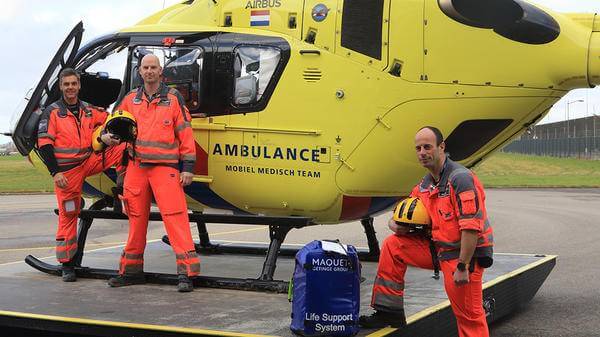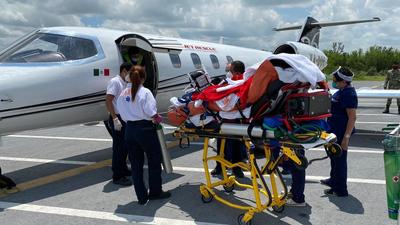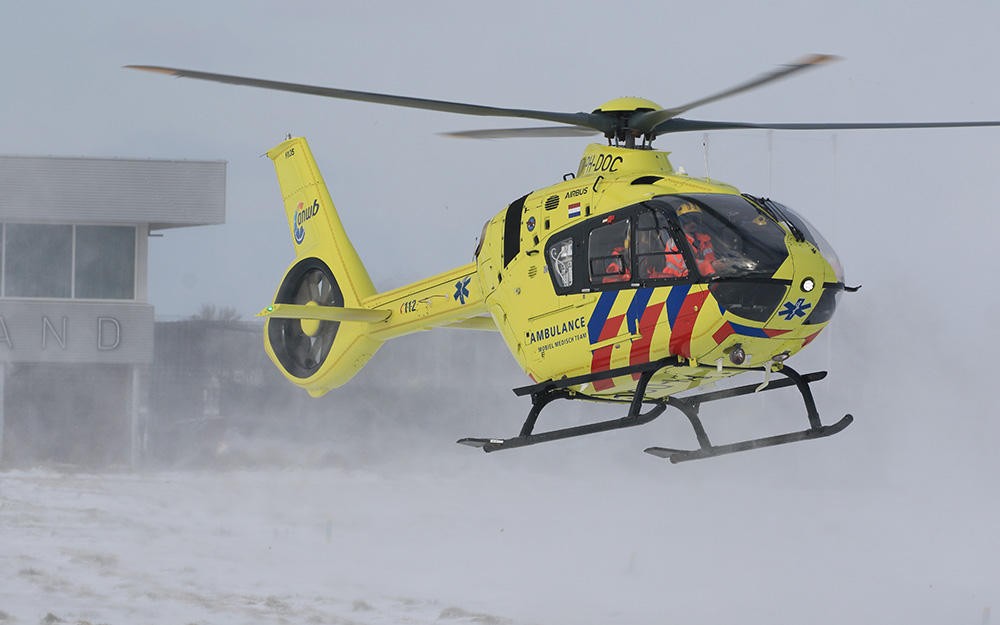Pre-hospital ECMO enters Dutch HEMS

A study currently underway in the Netherlands will ultimately deliver nationwide coverage of extra corporeal membrane oxygenation (ECMO) treatment onboard emergency medical helicopters
Last January, the first mobile heart-lung machine providing ECMO treatment was introduced to the Helicopter Emergency Medical Service (HEMS) at Rotterdam Airport, where Lifeliner 2 is based. During the next 18 months, the three other Dutch HEMS stations will follow suit in introducing the service. This move has made the Netherlands the first country to have nationwide ECMO coverage in place, improving cardiac arrest patients’ chances at a full recovery.
The ECMO treatment is combined with extracorporeal cardiopulmonary resuscitation (ECPR), where the in- and outflow of blood to the heart is connected to the ECMO machine. Project initiator and leader Dinis Reis Miranda MD PhD, anaesthesiologist-intensivist and HEMS physician, spoke to AirMed&Rescue about the decision to initiate nationwide ECMO services despite the inherent challenges.
By introducing ECMO during a refractory cardiac arrest, normal circulation can be achieved, which provides advantages when blood circulation, added with oxygen through the ECMO heart-lung machine, is recovered in an early, pre-hospital, stage. This was the basic premise on which a study was based that resulted in the equipment being carried onboard the helicopters.
The Netherlands is the first country to have nationwide ECMO coverage in place, improving cardiac arrest patients’ chances at a full recovery
Specific training needed for medical crew
Reis Miranda highlighted the essential – and specifically developed – training needed for physicians and nurses to ensure they are capable of performing ECPR in order to begin ECMO treatment. To apply ECPR, two cannulas are inserted into the groin and directed to the entry and exit of the heart. To perform such a precision action under out-of-hospital circumstances, the team had several dedicated training days to ensure all procedures were thoroughly practiced in various settings. “You could find us training in the middle of a field at the airport or narrow corridor in the hangar, so we have ensured we are always prepared for any scenario,” Dr Reis Miranda explained.
Clarity of patient information defines decision making
“It is important to have early and complete patient information from our emergency room, which initiates our alert dispatch to the resuscitation incident,” HEMS nurse Christiaan explains. An initial diagnosis means the team can determine whether or not the patient can be considered for ECPR. “During our flight to the incident scene, we verify again if the available information matches the criteria for ECPR. Finally, on scene, we check once more together with the nurses from the ground ambulance and make the decision whether or not to start ECPR.”
It is important to have early and complete patient information from our emergency room, which initiates the alert dispatch to the resuscitation incident
Care coordination
“To continue the procedure, our tasks are split up. Ambulance paramedics concentrate on all treatment above the patient’s diaphragm, like continuation of heart massage, respiration and administration of medication,” Christiaan continued. Meanwhile, the HEMS physician and nurse concentrate on their interventions below the diaphragm. The groin area will be sterilised, veins detected and cannulas inserted, and from then, the ECMO machine can be up and running in approximately 10 minutes, and the patient will be in a stable condition not long afterwards. In the subsequent 15 minutes, the patient is made ready for transport to the hospital, where dedicated and specialized follow-up treatment can be given.
Logistics of introducing heavy equipment onboard a helicopter
The on-scene role of Lifeliner 2 pilot Roel in this process is normally limited, as he stays with the helicopter to keep the aircraft and the surrounding area safe. However, there are times when he can join the medical team and is able to give a helping hand for logistics and coordination. During the preparations of the ECMO study, for instance, Roel was closely involved with all helicopter-related issues, such as the increased weight and position of the equipment in the cabin. Although it is a mobile unit, all the ECMO equipment together comprises a large bag weighing more than 30kg, which had to be examined carefully to find the right position in the helicopter together with the HEMS equipment already onboard. The ECMO machine found its position in the back of the Airbus H135, where it did not block any crew exits and remained safely within the helicopter’s maximum weight limits. “This is of high importance for flight safety,” noted Roel. “For example, when you lose one engine for whatever reason, you still have to be able to control the helicopter’s remaining power in order to come out of that dangerous situation.” To install the ECMO onboard the helicopter, only one simple modification had to be made – the addition of an extra electric connection to keep the ECMO battery charged.
Study outcomes will determine future moves
Complete introduction of ECMO services onboard the helicopter air ambulances providing air medical coverage of the Netherlands will be reached by the end of next year. The study will include 390 patients; a figure they expect to be reach in approximately two years’ time, based on historical data. The main criteria for patients to be included in the study are, amongst others, being between 18 and 50 years old and that the cardiac arrest was witnessed. Although a patient might initially meet the inclusion criteria, there are also various criteria that may result in exclusion from the study, such as patients with a ‘do not resuscitate’ order.
When the total number of patients is reached, analyses will be done on the data gathered to present the team’s findings and conclusions. These results will form the basis for further decision making on how to continue with ECMO treatment provision onboard the helicopters. Should a positive result of pre-hospital ECMO usage is firmly supported by the study statics, the criteria may become subject to review. A possible subsequent discussion might assess the age criteria, for instance, knowing that the number of cardiac arrests increases exponentially over the age of 50. On the other hand, increasing the scope of the patients’ age will likely affect the current capacity of hospital intensive care beds, as well as the capacity of the four Dutch HEMS stations. When relevant, it will be clear that such a discussion needs to be done in a broader setting as it will involve many key players in the medical chain.
Dr Reis Miranda pointed out that pre-hospital ECMO and ECPR treatment is already operational in HEMS units in other countries. Paris, France, Berlin and Regensburg in Germany, and Albuquerque in the US, are examples of current international operations. With their local city focus, however, this makes the Netherlands the first country with a nationwide covered pre-hospital ECMO service.
The other three Dutch HEMS stations are located in Amsterdam (Lifeliner1), Volkel Air Force base (Lifeliner3) and Groningen (Lifeliner4). The helicopters and pilots are delivered by ANWB-Medical Air Assistance. The HEMS physicians and nurses from Lifeliner 2 are delivered by the Erasmus Medical Center, while the other stations receive their medical teams from nearby located trauma specialised hospitals.

May 2022
Issue
In this issue:
Dynamic hoisting; wireless communication solutions enhancing crew coordination; we say au revoir to the RCAF CC-115; introducing pre-hospital ECMO - nationwide coverage in the Netherlands; CAMTS' Executive Director Eileen Frazer looks at what critical care means; HEMS pilot Mike Biasatti explains how hard work and dedication pay off; and Dr Julian Wijesuriya on Airway Management interactive online learning course.
Peter Ten Berg
Inspired by the dynamics of aviation and a passion for photography, Peter accompanies aircraft and helicopter crews to capture them at work and hear their story for his exclusive reports. His focus is on military aviation as well as governmental subjects including HEMS, SAR, UAV and rescue.










